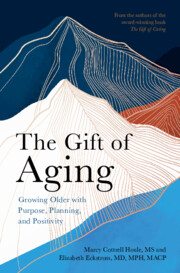Book contents
- The Gift of Aging
- Reviews
- Additional material
- The Gift of Aging
- Copyright page
- Dedication
- Contents
- Tables
- Contributors
- Foreword
- Introduction
- 1 Map and Compass
- Part I Caring For Your Mind
- Part II Caring For Your Body
- 13 Protect Your Bones throughout Your Life
- 14 Why Your Bladder, Kidney, and Perineal Health Matters
- 15 Maintaining Your Blood (Cardiovascular) System
- 16 Our Muscles throughout the Lifespan
- 17 The Wonderful World of Microbiota and the Value of the Mediterranean Diet
- 18 What Happens to the Immune System as We Age?
- 19 The Problem of Pain in Older Adults
- 20 Don’t Give In and Live with Pain
- Part III Caring For Yourself and Your Family
- Part IV Caring For Your Soul
- Acknowledgments
- Appendix: Elizabeth’s Original Mediterranean Diet Recipes
- Index
16 - Our Muscles throughout the Lifespan
Build Resilience Now to Prevent Frailty Later
from Part II - Caring For Your Body
Published online by Cambridge University Press: 08 June 2023
- The Gift of Aging
- Reviews
- Additional material
- The Gift of Aging
- Copyright page
- Dedication
- Contents
- Tables
- Contributors
- Foreword
- Introduction
- 1 Map and Compass
- Part I Caring For Your Mind
- Part II Caring For Your Body
- 13 Protect Your Bones throughout Your Life
- 14 Why Your Bladder, Kidney, and Perineal Health Matters
- 15 Maintaining Your Blood (Cardiovascular) System
- 16 Our Muscles throughout the Lifespan
- 17 The Wonderful World of Microbiota and the Value of the Mediterranean Diet
- 18 What Happens to the Immune System as We Age?
- 19 The Problem of Pain in Older Adults
- 20 Don’t Give In and Live with Pain
- Part III Caring For Yourself and Your Family
- Part IV Caring For Your Soul
- Acknowledgments
- Appendix: Elizabeth’s Original Mediterranean Diet Recipes
- Index
Summary
Most of us don’t build muscle mass after young adulthood. After we turn 50 our muscle mass decreases 1-2% per year. From our 20s until the age of 80, our muscle mass decreases by 30 – 50%! This becomes increasingly noticeable after age 70.Our strength declines by 10%-15% per decade until age 70, when this loss accelerates to 25% to 40% per decade. Sarcopenia, or muscle loss, often serves as a harbinger of frailty. But frailty is not normal with aging. The five factors of frailty (three must be met to be considered frail): Unintentional weight loss; exhaustion; muscle weakness; slowness in walking; low levels of activity. Multiple studies show that a good exercise program, including aerobic, strength, and balance regimens, preserves muscle mass in older generations. Chapter explains how frailty is a group of symptoms that can be effectively avoided or treated.
Keywords
- Type
- Chapter
- Information
- The Gift of AgingGrowing Older with Purpose, Planning and Positivity, pp. 107 - 111Publisher: Cambridge University PressPrint publication year: 2023



